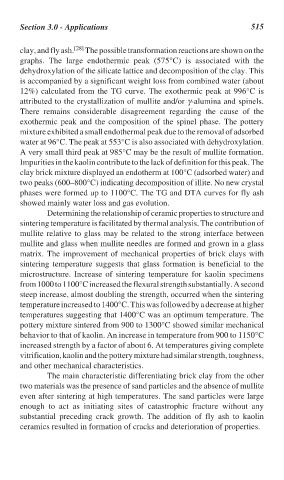Page 544 - Handbook of Thermal Analysis of Construction Materials
P. 544
Section 3.0 - Applications 515
clay, and fly ash. [28] The possible transformation reactions are shown on the
graphs. The large endothermic peak (575°C) is associated with the
dehydroxylation of the silicate lattice and decomposition of the clay. This
is accompanied by a significant weight loss from combined water (about
12%) calculated from the TG curve. The exothermic peak at 996°C is
attributed to the crystallization of mullite and/or γ-alumina and spinels.
There remains considerable disagreement regarding the cause of the
exothermic peak and the composition of the spinel phase. The pottery
mixture exhibited a small endothermal peak due to the removal of adsorbed
water at 96°C. The peak at 553°C is also associated with dehydroxylation.
A very small third peak at 985°C may be the result of mullite formation.
Impurities in the kaolin contribute to the lack of definition for this peak. The
clay brick mixture displayed an endotherm at 100°C (adsorbed water) and
two peaks (600–800°C) indicating decomposition of illite. No new crystal
phases were formed up to 1100°C. The TG and DTA curves for fly ash
showed mainly water loss and gas evolution.
Determining the relationship of ceramic properties to structure and
sintering temperature is facilitated by thermal analysis. The contribution of
mullite relative to glass may be related to the strong interface between
mullite and glass when mullite needles are formed and grown in a glass
matrix. The improvement of mechanical properties of brick clays with
sintering temperature suggests that glass formation is beneficial to the
microstructure. Increase of sintering temperature for kaolin specimens
from 1000 to 1100°C increased the flexural strength substantially. A second
steep increase, almost doubling the strength, occurred when the sintering
temperature increased to 1400°C. This was followed by a decrease at higher
temperatures suggesting that 1400°C was an optimum temperature. The
pottery mixture sintered from 900 to 1300°C showed similar mechanical
behavior to that of kaolin. An increase in temperature from 900 to 1150°C
increased strength by a factor of about 6. At temperatures giving complete
vitrification, kaolin and the pottery mixture had similar strength, toughness,
and other mechanical characteristics.
The main characteristic differentiating brick clay from the other
two materials was the presence of sand particles and the absence of mullite
even after sintering at high temperatures. The sand particles were large
enough to act as initiating sites of catastrophic fracture without any
substantial preceding crack growth. The addition of fly ash to kaolin
ceramics resulted in formation of cracks and deterioration of properties.

